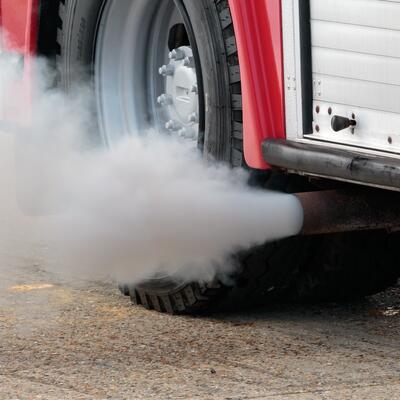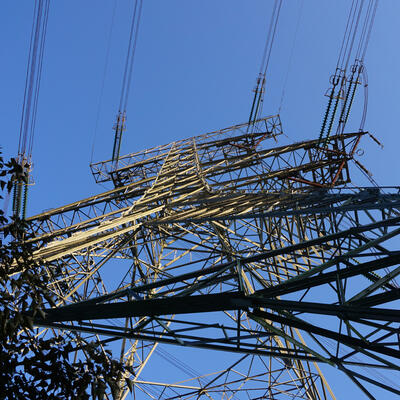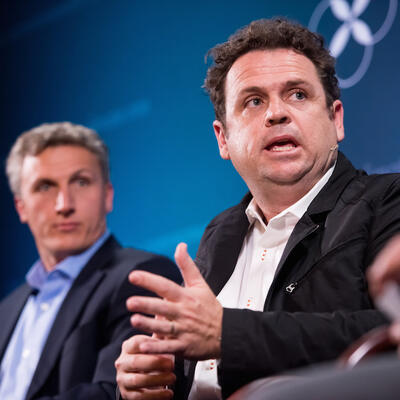
Will Trump Force One Run Clean?
Guests
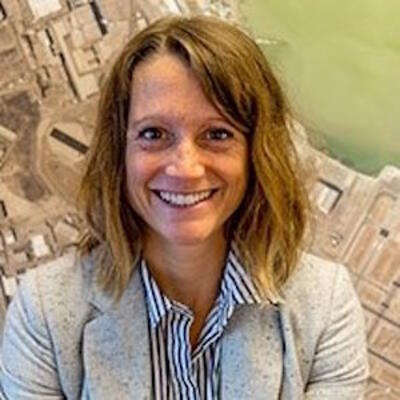
Erin Cooke
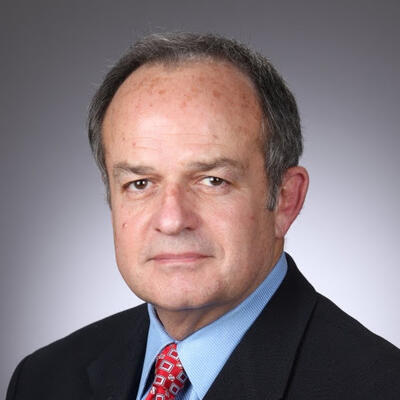
James Macias
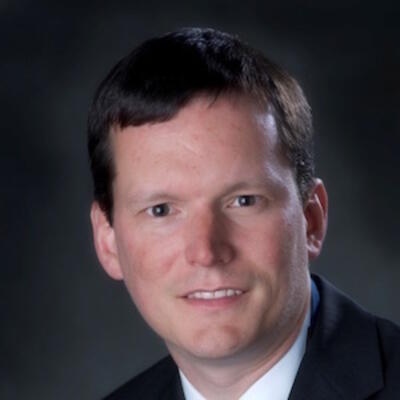
Sean Newsum
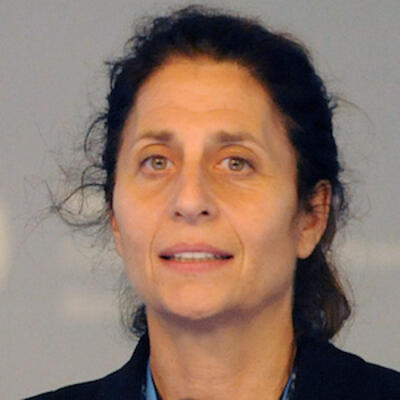
Annie Petsonk
Summary
A recent agreement is designed to curb emissions from international plane flights. But what if the new administration doesn’t clear it for takeoff?
Erin Cooke, Sustainability Director, San Francisco International Airport
James Macias, President and CEO, Fulcrum BioEnergy, Inc.
Sean Newsum, Director of Environmental Strategy, Boeing Commercial Airplanes
Annie Petsonk, International Counsel, Environmental Defense Fund
This program was recorded in front of a live audience at the Commonwealth Club of California on November 16, 2016
Full Transcript
Greg Dalton: From the Commonwealth Club of California this is Climate One, leading the conversation about America's energy, economy, and environment. I'm Greg Dalton.
On the show today, we’re going to Bali, well, we’ll talk about flying to Bali or Paris, and other exotic and romantic destinations. A new agreement reached in Montréal earlier this year will reduce the carbon pollution from international plane flights. The aviation industry and 191 countries are on board and airlines hailed the voluntary deal as historic. The travel pact is separate from the Paris climate accord in which nearly 200 countries agreed last year to go on a carbon diet of their choosing. But Donald Trump's pledge to exit the Paris agreement is raising questions about the aviation deal. What happens if the United States doesn't clear it for takeoff? will airplane manufacturers and airlines set their own flightpath? This program is underwritten by our friends at the ClimateWorks Foundation. And over the next hour we will talk about lighter airplanes, aircraft powered by batteries and the sun, cleaner fuels. And what San Francisco International Airport is doing to cut its greenhouse gas emissions. We might even learn what really happened to the paper or glass you put in the trashcan at SFO that says, “contents recycled off-site.” Seriously?
Joining our live audience at the Commonwealth Club in San Francisco, we’re pleased to have with us four people working to clean up your summer trip to Disney World. Erin Cooke is Sustainability Director at San Francisco International Airport. Jim Macias is President and CEO of Fulcrum BioEnergy, a startup based in the East Bay that is backed by BP and United Airlines. Sean Newsum is Director of Environmental Strategy at Boeing Commercial Airlines and I don't think any relation to our former mayor. Annie Petsonk is International Counsel of the Environmental Defense Fund and was deeply involved in the new travel agreement. Please welcome them to Climate One.
[Applause]
Greg Dalton: Annie Petsonk, you’ve been involved in this deal for years as aviation deal. Can Donald Trump dump this aviation deal?
Annie Petsonk: The important thing about the aviation agreement that was reached in Montréal a couple weeks ago, is that it’s got broad support from across the industry and it’s got strong support from civil society organizations. Now, not every environmental group thinks it's perfect. It's not perfect by any means. But as a first step, it’s quite an important one. And it relies on giving airlines the flexibility to determine how they’re gonna reduce emissions. They can do it by flying cleaner aircraft, they can do it by working with governments to get air traffic control to be better so that planes can fly, takeoffs and landings more efficiently and they don't have to spend so much time circling. They can use alternative fuels if those fuels actually reduce emissions. And they can offset their emissions by investing in emission reduction opportunities within the aviation sector like at San Francisco Airport or outside the aviation sector. With that flexibility in mind, we’re hopeful that the new administration coming in will embrace this agreement and not reject it.
Greg Dalton: Sean Newsum, in 2008, the federal government bailed out the auto industry particularly GM and Fiat. And then as part of that, there was agreement to increase CAFE fuel efficiency standards. Couple of days after President Trump was elected, the auto industry came out and said, “Actually we want to renegotiate that. That thing we committed to, we wanna ease off those fuel efficiency standards that we committed to.” What is the possibility that the airline industry will do the same thing and say, “Well, that thing we agreed to, we changed our mind. We want to loosen that a little bit.”
Sean Newsum: Well, you know, the difference for us is that we actually, we’re seeking having fuel efficiency standards for aviation. We didn't have one for our industry. There were for the automotive industries, although in individual countries not in a international sectorial basis. So we actually sought this, it’s something that we supported it’s something that we still support. And the change in the administration isn’t gonna change our industry stance towards wanting to have that in place. We reached an agreement through the same United Nations body that agreed on the market-based measures. It's one of the pillars of our environmental strategy. And as far as we're concerned, we’re planning to move forward on implementing that standard.
Greg Dalton: So, Jim Macias, you run a biofuel company, you’ve receive money from the federal government. You’re getting questions, what’s this mean for our business?
James Macias: Yeah, I don’t see there’s gonna be much of an impact especially with the longer term. There may be some short-term impact but not over the longer term. You asked about the airlines’ commitment. In our business we produce renewable fuels by converting the garbage. We can produce diesel or jet same costs very easily.
We’re focused on jet for a simple reason, diesels. Better market; you can sell it at a lower cost. You don't have all the safety issues that you do with aviation fuels. You don’t have all the certification and documentation for folks on the aviation industry because aviation industry is absolutely determined to get to sustainability in their business. I had an opportunity to meet with in discussions with a lot of airlines, the CEOs and senior executives. They are absolutely convinced that it's a critical business function to their success of the future to be competitive in a very competitive environment; to have a sustainable business with a lower carbon input. This is beyond any government input. This is beyond regulations. They see it's a matter of survival and they're willing to get involved and help companies like ourselves get there faster with the large volumes that they need to fly.
So the Trump administration, I'm not sure what they're gonna do. He’s made it known that a lot of his positions during the campaign were opening positions. What’s gonna actually happen, but I think this is clear, what's happening in the aviation not just the civilian but the military. The military is also convinced they need alternative fuels for their fleets and their operations. So it's bigger than any single president or administration.
Greg Dalton: Erin Cooke, how about SFO. You’re not, you know, you're kind of the regional entity there, an island of sorts. How would a change in policy in Washington affect what you're doing at San Francisco International?
Erin Cooke: We’re a city department, so the city of San Francisco we’re a department within that. And we are really home to a very sophisticated public that we’re serving as part of their passenger journey. So about 70 million actually Bay Area residents are flying on an annual basis, 51 million are coming through our doors.
And we recognize that they have a strong environmental ethic as well as affinity towards technology that is helping contribute to the betterment really of our planet and also their travel experience. And so from really home to airport gate, we’re making sure that and our city is widely supportive of this through a variety of different policy as well as market-based mechanisms making sure that they’re taking air train and or BART to get to our terminals which are all very low carbon transportation sources. They're actually being able to access concessions or services at our airport which are within a LEED portfolio. So 24 of our buildings are actually LEED certified or registered to become LEED Gold which is a green building standard set by the city of San Francisco which is the most progressive really in the nation.
We’ve done a lot actually also on airside. So making sure that we’re providing PC air, so our airplanes that are coming in for clean, to clean as they’re waiting for takeoff can actually not idle, they can plug into our system which is actually all provided through a hundred percent GHG free electricity. So that’s a program that’s available to SFO. We’re about 40% of the load at the PUC. And so we really think that as long as our city continues to lead, which we anticipate that it certainly will, we’ll be in a really good shape.
Greg Dalton: Sean Newsum, the aviation industry is growing. There are middle classes in China, India that are starting to travel internationally, huge growth. So paint for us the picture, the growth trajectory for airlines and airline travel that really sets the stage for this agreement.
Sean Newsum: Yeah, so, you know, overall air traffic around the world has grown at about 5% per year for the last 25 years at least. But where that growth occurs keep shifting and so looking forward over the next 20 years or so. We expect that the greater amount of the growth is in the developing countries and the emerging countries, the emerging economies. China, obviously a big source of that. But the greater Asia region, we expect to have the highest growth rates. We can expect air-traffic, air travel to continue to grow in the U.S. and Europe and in the regions and flights between those regions, but at a much lower rate. The really rapid growth is occurring in China and those developing nations.
Greg Dalton: And Annie Petsonk, if that growth continued and there was no deal to cap greenhouse gas emissions, how big of, aviation is what, 1% to 2% of global emissions. Where would it be without it they didn't bend the curve down and have this deal?
Annie Petsonk: The growth in this industry that’s forecast is so great that it could prevent the world from achieving the Paris goals of stabilizing the increasing temperature at no more than 1 to 2 degrees, one and a half to 2 degrees above preindustrial levels. Just to put that in context, I think and Sean correct me please if I'm wrong here, but I think that Boeing forecasts about 30,000 new large aircraft taking to the skies in the coming decades. That's a lot of planes producing a lot of greenhouse gas emissions and adding to the blanket of warming chemicals in our atmosphere.
Sean Newsum: Yeah, so even though air-traffic rose at about 5% every year, CO2 emissions grow less than 2% a year. That’s because we’re continually investing in new technology airplanes. We’re getting more and more fuel-efficient. Each new generation of airplane we produce is 15% to 20% more fuel-efficient than the one it replaces. So I flew here on a 737 next generation that first entered service in 1997. Later this year, sorry next year, we’re not in 2017 yet, we’ll deliver the next generation of the airplane the 737 MAX that will be approximately 20% more fuel-efficient than the original 737 that we delivered 20 years ago. We’re continuing to invest in technology, we’re continuing to make our airplanes more fuel-efficient. That's what makes for the difference between that 5% industry growth rate and on less than 2% emissions growth rate. Is the industry growing? Yes. Is it growing at the same rate as a traffic? No. Not from a CO2 emissions standpoint.
Greg Dalton: And you’re doing that because fuel cost is what, 30%, 40% of running an airline versus putting gasoline in a car is a small percentage of running our personal cars. So there's more of a business incentive to do this on airlines. Government is not making you do it.
Sean Newsum: Absolutely. The primary business driver for aviation is fuel efficiency. That's, fuel is their number one cost component so there's a natural incentive to invest in fuel-efficient technology. You know, contrast cars and airplanes, the thing that makes you buy a new airplane is the fuel efficiency of that airplane. The thing that makes you buy a new car, I don't know it's up to you. But generally speaking, I don't think fuel efficiency for the population as a whole for the mainstream product is fuel efficiency.
Greg Dalton: And so tell us some of the new technologies whether it's batteries, biofuels, a solar plane recently flew around the world. Can we dream of flying in a solar plane in our lifetime?
Sean Newsum: We can dream about it.
[Laughter]
Probably not happening real soon at least not on a commercial airline basis. I fully expect that somebody will build an individual general aviation type airplane that could be solar powered or electric powered certainly, you know, in the relatively near future. But from a commercial airplane basis, to get a 737 size airplane or 787 size airplane to fly on solar power and electric power, that's quite a ways off. So we've turned to sustainable aviation fuels, biofuels, as being what we think the best means to significantly substantially reduce the CO2 emissions footprint of airplanes.
Greg Dalton: Jim Macias, tell us where you’re getting your fuel from. There are all sorts of companies out there flying, providing fuel to airplane. Some of it comes from wood, some of it comes from corn. Some of it comes from algae and goopy gooey stuff in the ocean. What do you burn?
James Macias: Well, we don’t burn. Burning is dirty, sends emissions into the atmosphere. We’re close with gasification. Our feedstock is and this was solid waste or garbage. It’s all garbage that everyone here throws away in their black bin. It’s not recycling stuff, that goes on to recycling. It's a stuff that is not curbside recycled. About 50% of that garbage that’s thrown in the black bin is organic; it's rich in carbon and hydrogen. And we put it through a process to separate out all the non-organic, all the rocks, dirt, grit, glass, metals, that goes to recycling, surplus plastic goes to recycling. The rest we put into a feedstock and then in closed-loop gasification. Just take those complex molecules, break them up into simple molecules and then we convert them into a fuel product. It’s the same process that the earth use in fossil fuels so it’s down in the ground where there's no oxygen but it's high pressure and temperature converted all those fossil molecules into oil and natural gas and the products. We’re doing the same thing but in a controlled environment; instead of millions of years we do it in a matter of seconds.
Greg Dalton: If you’re just joining us, Jim Macias is CEO for Fulcrum BioEnergy. Our other guests today at Climate One are Erin Cooke, Sustainability Director at SFO. Sean Newsum, Director of Environmental Strategy at Boeing. And Annie Petsonk, with the International Counsel of Environmental Defense Fund. I'm Greg Dalton. Sean Newsum, low oil prices right now, does that affect this, it’s like oil prices. There’s an oversupply really in global oil markets the last couple of years. Does that take some of the pressure off for this?
Sean Newsum: I don't think so. And I say that for a couple of different reasons. Jim mentioned this earlier, but the imperative to reduce our CO2 emissions footprint goes beyond the price of oil. We recognize that this is an imperative for our industry. We've made strong commitments for improving our environmental performance overall. That's why we were so supportive of the market-based measures to carbon offset agreement that Annie mentioned in the United Nations Agency. That's why we’re investing as an industry in biofuels like with Jim's company. We see that that's something that is necessary for the long-term of our industry the long-term good of aviation. So we’re continuing to pursue that. The price of oil as a manufacturer is kind of a balance. For airlines to buy new airplanes from us, those more efficient airplanes, they have to be healthy, financially. Generally, they're more healthy financially when the price of oil as well. When the price of oil is high, they have an extra high motivation to get more fuel-efficient airplanes, but maybe they’re not as profitable. So overall, it kinda works out to be a balance and there isn’t really one state that's particularly advantageous to the market for new airplanes or the overall direction of our industry.
Greg Dalton: And over the lifetime of an airline, there’ll be high and low probably.
Sean Newsum: Absolutely.
Greg Dalton: Jim Macias, you mentioned the military, the U.S. Navy has done a lot of work, they’re great green fleet. Tell us about what they're doing to advance the technology and start to create some demand for companies like yours and there are others around California and Colorado and really around the country.
James Macias: Well, they’re very active in using the purchasing power of the Pentagon to help move the industry forward. Their planning horizon starts at 20 years out. They are very concerned about the sustainability of fossil fuels for their operations.
They have invested in us, they’ve invested $70 million in our plan to help accelerate our plan and get it producing fuel for their operations. It comes out of the National Strategic Defense fund. They see this as a strategic initiative. The Navy consumes a vast amount of fuel for their fleet. And I don't remember the number that they say it was like 60%, 70% of the fuel goes to keeping the shipping lanes open just to keep the flow of oil flowing globally. So it is a very important strategic initiative. Now they cannot purchase fuel at higher than market prices.
They ran the great green fleet operations I was with them this past summer, out in the Pacific, where they did Rim Pact with 20 other nations running on biofuels on the ships because they can purchase fuel at market prices, diesel for ships can be competitive. But no plane flew because aviation fuels aren’t competitive yet. And that's why they're pushing us real hard to get large volumes of fuel out into the marketplace so they can start using it. And we have to be competitive, even at low oil prices like today you still have to be competitive in the marketplace. The airline industry is so competitive. No airline can afford to pay even a fraction of a cent more for fuel than their competitors do. So you have to produce alternative fuel at competitive prices.
Greg Dalton: Annie Petsonk, another highly competitive industry is shipping. If you look at the story of regulation of greenhouse gases it started with big plants and factories, things that were regulated and they couldn't be moved. And then it went to cars and now we’re getting to mobile sources, planes and ships. So tell us about ships and when will they be brought into something similar to what the airlines have just done?
Annie Petsonk: How did we get started with planes and ships. Well first, when the parties to the framework convention on climate change, the Rio Treaty that was done back in 1992, sat down to figure out which emissions the different countries needed to reduce, the countries couldn't reach agreement on whose responsibility it is to cut the emissions of a flight from one country to another. Should that flights emissions be the responsibility of the country of departure, should it be your responsibility if you happen to be flying on the flight? Whose responsibility is it, they couldn’t agree. And they kick the issue around for many years until finally they reached agreement a couple of weeks ago in Montréal addressing whose emissions they are and capping and reducing those emissions.
Our hope is that that agreement can serve as a kind of model for shipping where you have the same question. Whose responsibility is it to deal with the pollution of a ship that’s going from one country to another? Shipping tends to be, it tends to use a lot dirtier fuels than aviation does. And ships are not nearly as much in the public eye as aviation is. So shipping is gonna be a tougher challenge. The shipping countries met in London a couple weeks ago after the aviation deal was reached. Instead of saying, hey that aviation deal will be a model for us. They said, well, let’s think about this until 2023 and then maybe we’ll develop a plan of action. From my perspective that's not a good first step. And so one of the things that I and my colleagues will be turning our attention to is not just getting the aviation deal implemented, but going after shipping as well.
Greg Dalton: Sean Newsum, how important is it that what customers, flyers kind of pressuring or saying to airlines that their carbon impact is, they touch consumers in a way that shippers don't. We all buy stuff that comes on a cargo container from China, but we never see that ship or have interaction with it. But lot of people, not all Americans, sit in an airplane and think about the carbon impact of that and have an interaction with that airline. How important is that customer touch?
Sean Newsum: Well, our airline customers and ourselves as manufacturers, we’re very aware of what the public, I shouldn’t say very aware, we’re very concerned about what the public thinks about the environmental footprint. We are aware, we think we’re aware of what the public thinks but we never really know. Our customers, our airline customers are a little more in touch with the direct flying public because there are direct customers. They pay attention. They do surveys of their customer base to understand what their thinking is, what the requirements are and they listen.
Greg Dalton: I was on a flight a few years ago on Virgin Airlines going to New York to a climate conference. And I love flying on Virgin, I wish more airlines were like that. And you have a little screen, order a sandwich, drink and oh, carbon offset. Like, yeah, I clicked that, alright. And then the flight attendant comes and says here's your drink. Here's your sandwich. I can't find that carbon offset. She’s looking in her basket and her thing. They're like, don't worry it’s like the thing that I put some money at to make myself feel better. It's not an actual product in your bag. But Annie Petsonk, a lot of people are suspicious about carbon offsets, whether they really do anything or it’s just making me feel better and throwing some money at our problems so I feel better, but it doesn't really reduce carbon. Is that fair?
Annie Petsonk: The big challenge in the aviation agreement is to make sure that the carbon offsets and biofuels that airlines use to meet their targets result in real reductions. And so for the offsets, the agreement provides that countries will have to obey very strict standards for proving that the offsets are real. And I'm part of the technical committee that is working over the next roughly 12 months, Sean is also involved in this, to make sure that the standards for evaluating those offsets are transparent so the public has an opportunity to see what programs are applying to be used by airlines as carbon offset programs. And the public has an opportunity to comment on them and also that you can see the cost of them transparently in your air ticket.
Last time I flew to Europe, I was very surprised to see that on a roughly $1,200 ticket, $600 was for something called international surcharge. What is that? Take a look next time you fly. We want to be sure that the airlines are required to be transparent with the public. How much does it cost them to procure these carbon offsets and to make sure that's the cost that’s reflected on your ticket.
With regard to biofuels, there are also major questions that the environmental community has. If you get your biofuel by chopping down a rainforest in order to grow a biofuel crop, you're actually making the climate problem worse. And so we're working to make sure that there are very strong standards for measuring the lifecycle emissions of these alternative fuels in comparison to fossil fuels.
Greg Dalton: Erin Cooke, there used to be kiosks at SFO to do offsets, cool thing. They went away, so do you use offsets at San Francisco Airport to offset some of the emissions that come out of there?
Erin Cooke: We’re actually really committed to making sure we’re mitigating and offsetting our emissions through our own operational portfolio first. So part of that is an allegiance in alignment with the Airport Carbon Accreditation Program. It has basically four stages or four levels of carbon disclosure and offset or mitigation.
SFO is one of two airports in North America that's achieved a Level 3, which is a carbon or climate mitigation. So our emissions as an airport are about 26 million tons, sorry, 26,000 tons, oh my goodness, yes, 26,000 tons. Sorry, that’s a very scary number, 26 million. And that’s for our scope one and two emissions, so our direct and indirect emissions that does not include aviation nor actually travel through other transportation partners. So when you add in our aviation services, that adds it or increases it to 1.6 million. So just our campus and that’s using, you know, 450 gigawatt hours of energy a year which are all the majority of which are GHG free which I mentioned earlier. It’s that 26,000 tons that we’re working on offsetting and mitigating initially.
And we have basically a strategic plan, a five-year plan to help us get to carbon neutrality, zero net energy and zero waste that will help mitigate that further. And I think there's alignment in the industry that we want to do that, we want to focus on our operational portfolio first before we buy or procure offsets. Which gets you actually do that stage 4 of carbon accreditation which is carbon neutrality. But we’re not playing in the offset market just yet. We want to really work on getting our house in order and reducing our footprint initially.
Greg Dalton: Speaking about getting your house in order. There's two parts to the climate challenge. One is reducing carbon pollution, the other is getting ready for climate change that’s already happening baked into the system. So that gets to the runways at SFO, projections for them to be underwater for seas to rise at some point. What are you doing to keep them dry and safe?
Erin Cooke: So SFO is obviously from a business continuity and a public health perspective very committed to climate change. Obviously that mitigation work that we’re doing including the hopeful addition of biofuels which reduces low-sulfur, sulfur fuels on our airfields creates a better workforce and a better environment for our workers. We have 35,000 workers at SFO on a daily basis, a majority of which are actually out in our airfield.
We also want to make sure they're not underwater and so we’re part of a variety of different working groups. The mayor has a sea level rise task force. We’re part of regional initiatives that are focusing on adaptation and resilience, recognizing that we’re really the headwaters to the majority of communities that are located in San Mateo County. And so we have invested in additional earthen berms actually elevating the level of our sea walls; about two-thirds of our 8-mile shoreline are already reinforced and protected. But we’re about to embark on a $58 million we’re calling it an adaptation resilience planning exercise essentially. To be able to build additional infrastructure and understand what additional mitigations are required to ensure the longevity of our airport.
Greg Dalton: Erin Cooke is Director of Sustainability at San Francisco International Airport. We’re talking about flying and climate change at Climate One. I'm Greg Dalton.
We’re gonna to our lightning round. Brief questions, brief answers. This one is true or false for Sean Newsum. Big oil companies are not great innovators, true or false?
Sean Newsum: It has to be true or false.
[Laughter]
Big oil companies are not the only innovators.
Greg Dalton: Okay. Annie Petsonk, true or false. Trump Force One is exempt from the international aviation climate agreement?
Annie Petsonk: Great question.
[Laughter]
It applies only to commercial flights.
Greg Dalton: So all private planes are exempt.
Annie Petsonk: So – not private planes, but military and state aircraft are exempt.
Greg Dalton: Okay.
Annie Petsonk: That’s not to say they can’t do it voluntarily if they want to.
Greg Dalton: Trump Force One is now a state aircraft, okay. Erin Cooke, true or false. Due to rising seas one day SFO will add boat docks near its aircraft gates?
[Laughter]
Erin Cooke: We already have some, true.
Greg Dalton: Boat docks? Depends how close?
Erin Cooke: Yeah, exactly, yeah.
Greg Dalton: The Coast Guard is not far from your runways.
Erin Cooke: Yeah.
Greg Dalton: Jim Macias, true or false. Carbon offsets are sometimes fishy?
James Macias: It can be true.
Greg Dalton: Annie Petsonk, true or false. The deal cutting airline carbon emissions is an example of slick greenwashing?
Annie Petsonk: False.
Greg Dalton: Sean Newsum, true or false. Boeing is going to make plane loads of money under President Trump?
Sean Newsum: I expect our business to be, to continue as it is under Trump.
[Laughter]
Greg Dalton: Jim Macias, true or false. Oil companies won't get serious about renewable fuels until they are as profitable as fossil fuels?
James Macias: True, but I think that’s already happening, yeah.
Greg Dalton: Okay, we can come back to the profitability of that. Annie Petsonk, true or false. The Environmental Defense Fund will raise more money with Donald Trump in the White House than they did with Barack Obama in the White House?
Annie Petsonk: Out of my league, man.
Greg Dalton: Think that environmental groups raised a lot of money with George Bush in the White House and after he left donations went down. Erin Cooke, true or false. The apocalypse is near?
Erin Cooke: False.
[Laughter]
Greg Dalton: It wasn’t very convincing false.
[Laughter]
Erin Cooke: Or maybe.
Greg Dalton: Sean Newsum, yes or no. Fuels from algae will save our bacon?
Sean Newsum: False.
Greg Dalton: Okay. Last question for Sean Newsum. Airline consolidation has created airport monopolies and raised ticket prices, yes or no? There used to be nine major carriers in the United States. Now there are four.
Sean Newsum: I’d say false.
Greg Dalton: Okay. An AP study earlier this – last year found that to be the case. Let’s give them a round for getting through that gauntlet of that.
[Applause]
[CLIMATE ONE MINUTE]
Announcer: And now, here’s a Climate One Minute.
It’s hard to say what changes the new administration will bring. President-elect Donald Trump has already pledged to lead the biggest US Navy buildup since the Reagan Administration. But how will we power all those new ships? When US Naval Secretary Ray Mabus visited Climate One, he had high hopes for curbing the navy’s appetite for fossil fuels, with a project called the Great Green Fleet.
Ray Mabus: The Great Green Fleet is a Carrier Strike Group that was involved in The Rim of the Pacific Exercise which is the biggest naval exercise in the world every two years. And it was a nuclear powered aircraft carrier and its screening ships, a cruiser, several destroyers, a misnamed oiler, every service ship was steaming on a mixture of marine diesel and biofuel. Every type of aircraft that took off from the carrier was flying on a 50/50 mixture of aviation gasoline and biofuel. We did it to demonstrate that we can reach both afloat and ashore the Navy’s goal that we’ve set that by no later than 2020, at least half of all Navy energy, both on our ships at sea, our aircraft in the air and our bases will come from non-fossil fuel sources.
The Department of Defense is the biggest user of fossil fuels in the world. The US Navy is about a third of that. So we burn, in the Navy and Marine Corps, about 1 percent of all fossil fuels burned in the United States every year. We can bring a market. We can make it economical. We can bring the scale to this.
Announcer: That was outgoing U.S. Navy Secretary Ray Mabus, speaking at Climate One in 2014. As for the Great Green Fleet, it remains to be seen whether Mabus’ successor will continue the program. Now, let’s return to our live discussion with Greg Dalton at The Commonwealth Club.
[END CLIMATE ONE MINUTE]
Greg Dalton: Here at Climate One, we’re trying to hear more stories from the people up on stage. So Erin Cooke, I’d like to hear your story of how you came to where you are as the sustainability director at an airport. What’s been your life path that brought you to this right now?
Erin Cooke: It started when there is a housing development that I tied myself to a tree to stop it from happening. I guess I’ve always been an environmentalist. I've always had that environmental ethic, largely because, you know, my parents were certainly hippies of the 60s and really instilled the love of nature and environment for me. So I’ve always actually worked for climate impacted industries. So have an undergrad degree in natural resource science and business management and wanted to combine them into a recreation field. And it was around the time that the National Skiers Association announced their sustainable slopes charter so I wanted to go and put that in place for a ski area.
I did that for a little bit, worked for an environmental nonprofit in Boston. Actually as part of an insurance agency that was one of the first to offer a mileage-based insurance product. Recognizing that people that drive less should cost less to insure; they have a lower risk profile. Made my way to Cupertino, California as their first sustainability manager and then assistance to the city manager and work there on in kind of the company town that is Apple but a wonderful community incredibly progressive with great values oriented around creating their first sustainability plan, climate action plan, doing greenhouse gas emissions inventorying.
And this opportunity to join SFO's team arose, they were hiring their first sustainability director to work on really matrixing environment across the organization and helping them achieve what they were calling initially their BHAG, their Big Hairy Audacious Goals. Kind of the moonshot for SFO of getting to the goals I mentioned earlier so carbon neutrality, zero net energy, zero solid waste. And it seemed like an incredible opportunity to contribute to an organization that had a really strong environmental ethic and commitment to climate change and had for quite some time; has been awarded for a variety of things. But also stay part of serving, being a public servant.
Greg Dalton: Jim Macias, how did you come to running a bioenergy startup in the East Bay?
James Macias: Well, Fulcrum is the third company that I worked for. I was 20 years with the utility start as a plan engineering and became a senior officer for operations. And utilities are not known for innovation and creativity and it’s very focused on not making a mistake. When I left them, became a senior officer with an independent power producer that went, they had the most rapid, advanced, fastest growing business in the power industry. And even though it was a large company, it was still run by its founder who was a very innovative, creative. So I went from an environment where the focus is not making a mistake to not missing an opportunity. And so then I had an opportunity with, I knew people in private equity that wanted to do something like this.
I had friends that were trying to talk me into doing it. So opportunity to start the company just myself with some funds from private equity a chance to run it yourself and do it yourself and do it how you want to do it. That’s how I got started.
Greg Dalton: Yeah, not many utility executives go into, become entrepreneurs, right? Sean Newsum, how did you get to your path being one of the green guys of Boeing?
Sean Newsum: Well, I’m an aviation geek from way back. I grew up in the Seattle area and Boeing was always there and I loved airplanes. My first job working for Boeing was on the first environmental issue for airplanes, noise, so airport noise, airplane noise. That’s where I spent the first years of my Boeing career at. And opportunity came around, several years later to get involved in broader environmental topics and here I am.
Greg Dalton: And Annie, how did you get to Environmental Defense Fund to this international area as well chasing down planes and pilots? Maybe not pilots.
[Laughter]
Annie Petsonk: Think of a really blue sky day. Imagine it in your mind. I went to school in Colorado Springs, I went to college there. And the town used to boast that it had 310 sunny days a year. But many of those sunny days turned cloudy by the end of the day. And so my college class decided to take some time lapse photography of the city of Colorado Springs. We started at dawn, we took a picture, 15 minutes later we took another picture, 15 minutes later another picture all the way through to sunset. That movie we ran backwards. Sunset was gorgeous, orange cloudy sky. As it rolled toward afternoon, the sky was gray. As it rolled toward midday, the solid gray sky broke up into bands of clouds.
By morning those clouds turned into strings. And by early morning those strings disappeared into the back of airplanes. That got me wondering.
Greg Dalton: So an actual experience of the clean skies. We’re gonna get toward audience questions. But I wanted to circle back to, you know, working on climate you’ve all shared your story working on various areas, very hopeful areas of climate. The last week or so has been pretty rough for people who are concerned about the climate. So Erin Cooke, tell me about learning about the change of the election and having a person who right now denies climate change in the White House. What was the emotional reaction and how you’ve been keeping yourself going?
Erin Cooke: What I will share on stage is that I am a mother and so that requires you to be optimistic. I would say on all parts, whether it’s getting through sleep deprivation or overcoming political challenges or seeing the opportunities in a light through all of those things. So interestingly enough that while the election was happening, I was in San Diego, meeting with the California Airport Council. And so I think there was a great light of hope in meeting with my colleagues from other airports throughout California, where we really are leading the nation in terms of commitment to climate change mitigation, adaptation and resilience. So just the story shares that we are having and all coming together and recognizing that we were sharing best practices of the way that we’re deploying, you know, great infrastructure projects at our airports. SFO is in the middle of a $6 billion capital plan that full plan deployment will be under a LEED Gold and hierarchy using version 4 which really focuses on indoor air quality and human health component.
So just talking to each and every one of them I think we are becoming increasingly optimistic for a variety of reasons. I think two also, or sorry, one initially being that we know that Trump is a builder, right. I mean his platform was about building bridges which we hope will include physical bridges as well as potentially jet bridges or bridges at our airports, right. And we also know that he is driven and motivated by economic performance. And so we recognize that in California, we’ve been able to show great opportunity through investment in green clean jobs that those are incredible workforce pathways and opportunities for real high-quality jobs. So making the business case for that and then also recognizing what I said earlier around business continuity and the risk that comes from not addressing the insurance flood risks and potential impacts that climate change really does bring to our country, our country’s infrastructure. That he wants to reinforce through the projects and investment under his administration.
Greg Dalton: Annie Petsonk, what was your reaction and do you know some people, do you have family members who were Trump supporters?
Annie Petsonk: I’m from Pennsylvania. I’m from a town that has been hollowed out economically. We used to have manufacturing in our town. We used to have railroads, we used to build railroad cars. I’m committed to trying to get jobs in my hometown. In the part of Pennsylvania where I'm from, the rising industry right now is heroine. We can't go on that way. Fighting climate change can generate new technologies. My dad was an engineer. He helped design the reversing propeller for the blimp. One of his Boy Scouts in a scout trip, that he was a Scoutmaster of designed and invented lightning arresters that are on every airplane now. If lightning strikes the plane, these lightning arrestors dissipate the charge.
The aviation industry is a cornucopia of technology innovation. And by starting with aviation as a template for tackling climate change, I think we can generate technologies that can put people in towns like my hometown back to work making those air aircraft components and technology components. Whether it's for air traffic control systems or the aircraft themselves or for innovations that spin off of those and can be used in other sectors like electrical power plants other sectors. We can do it and we need to do it. We need to do it to protect the climate and to put people back to work.
Greg Dalton: Annie Petsonk is with the Environmental Defense Fund. Jim Macias, did you ever have a lump in your stomach thinking about, uh-oh, this could be a big change that could affect me, my family, my company?
James Macias: No. When you’re running a business, administrations come and go, presidents come and go. You can't run a business that has a strategy that's focused on a certain government direction or policy. You deal with uncertainties all the time well this is just another uncertainty you wanna do. But what has me the confidence is the driver that striving this like the agreement that was reached in the aviation industry. That was voluntary, that was not government driven. It wasn’t like the automobile industry where it was government mandated and now all the car industry may be looking to change it. This was driven by the airlines because the paying customers in their views they want to see it, it's needed. So this is public driven. It's not government driven. And so there will be some impact plus or minus. But in the scheme of things, it is just more either wind in your face or wind in your back. And this is one of the things you have to deal with as a company.
Greg Dalton: Sean Newsum, tell us about your emotional ups and downs this last week, last week or so. The election surprise, you’re a parent also.
Sean Newsum: Yeah, certainly I was surprised. I’m a big follower of Nate Silver's FiveThirtyEight blog and for really the last two or three election cycles. And so I’ve been tracking the probability for months. And so, you know, I think that prior to the election it was like a 65% Clinton win. I was like, okay, so 2 to 1 that’s a pretty good odds. And so when it didn't come out that way, there’s certainly a lot of surprise on my part just from a pure, I’m a data geek analyst kind of guy. But as Jim said, you know, big picture wise, we build airplanes the last 25 years. We’re looking ahead towards 2050 as our key environmental goal reducing our emissions as an industry at 50% by 2050.
And, you know, within that kind of framework within that kind of context and looking at this on an international basis, the things that Annie and I have been talking about here today and we've been talking about for years now. They’re an international agreement; they’re not reliant in any one country. The U.S. is a significant country in that but it's not the only country. And so in the whole context of things, yeah, this'll have some temporal impact, I don’t know what it’s gonna be yet. But we’re focused on the long-term and some bigger goals and some bigger issues.
Greg Dalton: Sean Newsum is Director of Environmental Strategy at Boeing. I'm Greg Dalton.
Let’s go to our audience questions at Climate One. Yes, welcome.
Male Participant: Hey, I’m Tobias Scholz [ph]. I work for SCS Global Services, which is an environmental consulting and certification firm. Now, Annie you mentioned the controversy about some types of biofuels, which we’re very, very familiar with. And you mentioned that there’s a, that you’re actually doing some work on that. Could you talk about what you see as the keys to ensuring that the biofuels that are gonna be used are good for the climate and not in fact bad for the climate.
Greg Dalton: Annie Petsonk, because we went through a whole chapter with cars. Where they yeah, put corn and it’s good. Oh, corn not so good. Okay. Is that gonna happen in planes?
Annie Petsonk: First, there's been a mythology that because crops take carbon out of the atmosphere to grow that when you burn them, in a car and airplane, that’s carbon neutral. But that's really an error in accounting. Because when you burn them in a car or an airplane, the carbon dioxide comes out the back of the tailpipe and goes up into the atmosphere. The question is what was going on in the land where you got those crops from. If you can increase the carbon storage on the land compared to what you were doing on the land before, then you might be able to produce those biofuels in a way that actually does benefit the atmosphere. But that requires looking at what's going on in that land and what's going on in neighboring lands as well.
It's controversial. Some people don't want the neighboring lands looked at as well and various countries in the negotiations over these standards, have their own views on it. We’re committed to try and to get that full accounting over the entire lifecycle. In addition, there are concerns about the sustainability from an ecosystem perspective and from a social perspective. If the place where you're getting your biofuels from happens to be in the middle of a pristine ecosystem where the animals who live there are gonna be displaced, that's a big concern. And so there's a grouping of NGOs who are working with governments who are also concerned about it to try to get these standards. When will we get it done? Not this year and not next year but maybe the year after.
Greg Dalton: Let’s go to our next question. Welcome to Climate One.
Male Participant: Hi, thanks. My name is James Loewen. Just curious to hear a little bit about some technical discussion or economics discussion about some other ways. And the question is, is biofuels the only game in town with respect to carbon free flying. Batteries were mentioned, what about, are batteries feasible? What about hydrogen going into fuel cells and so hydrogen created in a carbon free manner going into fuel cells for example?
Greg Dalton: Sean Newsum.
Sean Newsum: So the challenge here really all comes down to energy densities. So how much oomph can you put into a given volume. You know, in today’s airplanes the energy, the fuel is in the wings. All of these other technologies have significantly lower energy density than liquid fuels. Jet fuel is remarkably energy dense as are most liquid fuels. Hydrogen, liquefied natural gas, battery power, solar power, they all lack that energy density at this point. Battery is on a unique technology trajectory. It may get there sometime but right now the energy density comparison between battery power and a liquid jet fuel is about 20 to 1. So you’ve got to overcome that 20 to 1 ratio to get to the same level of capability we have today.
Greg Dalton: Fossil fuels have millions of years to pack it in there. Let’s go to our next question.
Male Participant: Hi everyone. I’m Moshier Ali [ph]. I'd like to take us back to the title of the talk and ask an umbrella question in terms of what a Trump presidency would mean to aviation. And I think the panelists alluded to this, there's gonna be a short-term impact and a long-term impact. And I think the way aviation mitigates the long-term impact is really having a good short-term answer.
For example, the short-term problem for civil society is how do you sell an aviation deal that even internally, there are some doubts that it could have an impact? How does an industry sell its commitment to climate change when you have a lifecycle of 25 plus years for aircraft? You know, once you finish this next generation that I think it's a great move forward for Boeing, there's going to be a lull for about 25 years. What do you do in that timeframe? In terms of biofuels the elephant in the room is really automobiles and ships. In terms of redirecting fuels to aviation you’ve got a bigger player and a bigger supply that's needed for other modes of transportation that will really fight aviation for biofuels. And in terms of airports, demand growth and keeping up demand is gonna be the bigger challenge that airlines are gonna want you to answer first before you answer your climate commitment. So in terms of all of those, in terms of having the right short-term answer to really mitigate a President-elect Trump for years, you really have to have those answers. And I’d like to know what the panelists think.
Greg Dalton: Let's tackle those quickly and we’ll get to the next question. Jim Macias.
James Macias: Well, I mean I can't speak for him. I haven't talked to him, but he has expressed very, he’s very pro-economy in growing the economy. I have a hard time seeing him getting in the way of where the airlines are going, what they're trying to do with improving efficiency and improving operations. So I think he’s gonna be focused on a lot of the all of the above energy strategy and looking to free up some of the regulations for drilling on gas. But I don't see him getting in the way of what the aviation industry is doing and with efficiency and agreements and with biofuels.
Greg Dalton: May not promote it but may not slow it down. Sean Newsum.
Sean Newsum: You know, that very issue is why we tumble towards supporting a market-based measures a global carbon offset program. We saw that as the gap filler that the short-term solution to essentially level out our industry wide CO2 emissions. We look at this as a portfolio approach. We want to continue to make more efficient airplanes. We wanna operate those more efficiently. We wanna do biofuels to make a substantial reduction in the CO2 emissions profile. But before all those things come together, we look at this carbon offset program as a means to provide that more immediate response to reducing our emissions.
Greg Dalton: We’re gona go to the next question. Yes, welcome to Climate One.
Male Participant: Hi, my name is Craig Wildman. My question is on biofuels for commercial aviation. So what does it take to qualify a new biofuel for use? Did you need a perfect drop-in fuel and if so, do you then have to have some long testing procedure or are you flexible with the chemistry of the fuel?
Greg Dalton: And can we run on French, can we fly on French fry grease? Jim Macias.
James Macias: Well, the aviation industry with Boeing’s leadership and help has already established the standard the ASTM standard for biofuel for aviation. And it’s been through engine testing and all the certification process and documentation. So it’s well known. So the standard, the pathway there for companies like ours is already there. You just have to follow that and you have to follow the certification and the rules and the criteria. It is a drop-in fuel that gets blended directly with fossil fuels.
Greg Dalton: Jim Macias, tell us briefly, you're about to build your first plant. How much fuel you’re gonna make and why are you doing it in California. It’s an expensive place to do business. Are you doing it here because of the laws, you’re doing it here because you like the golf courses, why?
James Macias: Well, we’re headquartered in California just here in the Bay Area. That's because I started the company that’s where I live, so why not start it.
Greg Dalton: It’s where you play golf, okay, alright.
James Macias: But our first plant is not in California. Our first plant is in, we’re constructing it right now in Reno and a lot of people ask why. Where in California and elsewhere, if you’re putting in a power plant, the rules for permitting and constructing the power plant are well-known. If you’re putting in a refinery, rules and regulations for permitting and constructing a refinery are well-known. You wanna do a landfill. Those are well-known. But what are we? We’re kind of in between. So when you talk to people it's not real clear. In California you talk to regulators, well I don’t know, we’ll have to figure this out. Follow your permits and then we'll figure it out, we’ll see what's going on. Other states in the country the regulations aren't any less. You still have to have the same air emission regulations, the same water use. But in Nevada, they were clearer. And it's very difficult to make a $250 million investment in these plants. These are bio mini refineries. With those kinds of rules uncertainty that you'll figure out as you go. So we’re building it in Nevada, we’re trucking the fuel here to SFO.
Greg Dalton: We’re gonna wrap up. For people who want to have some hope and know what an individual person can do in this space. Erin Cooke, what can an average flyer, traveler do who’s concerned about climate other than not get in an airplane I supposed?
Erin Cooke: Take BART or AirTrans to access the airport. Our airport has reduced emissions by 38% off of a 1990 baseline. So I don’t want to put in a plug for SFO but flying through SFO certainly helps mitigate your carbon impact of transportation.
Greg Dalton: Ooh take that Oakland.
Erin Cooke: Sorry. And, you know, certainly reach out and right to the airport if you see opportunities for improvement. I think we all are in a very kind of coopetition space and we want to compete with one another, recognizing that we’re all competing for towards the same passengers but there are tons of growth opportunity. So certainly feel free to reach out and give us some recommendations for improvement.
Greg Dalton: Jim Macias, what can an average flyer do? What can an average person do to reduce, tackle climate change?
James Macias: Well I think still being an educated, smart, demanding customer. That's what's driving the change in the aviation industry and I'd say keep it up.
Greg Dalton: Ask your travel about climate, about offsets perhaps. Yeah, Sean Newsum.
Sean Newsum: Make smart choices. Travel when you want to go, where you want to go. But make smart choices about when you do that. When you're asked by somebody in the industry what's important to you tell him that sustainability counts.
Greg Dalton: Annie Petsonk, last word.
Annie Petsonk: Don’t hesitate to tell them that sustainability counts, especially if they are the CEO of an airline or the incoming CEO of the nation.
[Applause]
That, we have to wrap it up there, we’ve been talking about sustainability and flying with Erin Cooke, Sustainability Director at SFO, Jim Macias, CEO of Fulcrum BioEnergy. Sean Newsum, Director of Environmental Strategy at Boeing and Annie Petsonk, International Counsel with the Environmental Defense Fund. I'm Greg Dalton. You can listen to a podcast of this at climateone.org. I encourage you to subscribe to the podcast and I’d like to thank our audience here in the room at the Commonwealth Club and online and on the air. Thank you all for joining us and thank these great guests.
[Applause]
[End]
